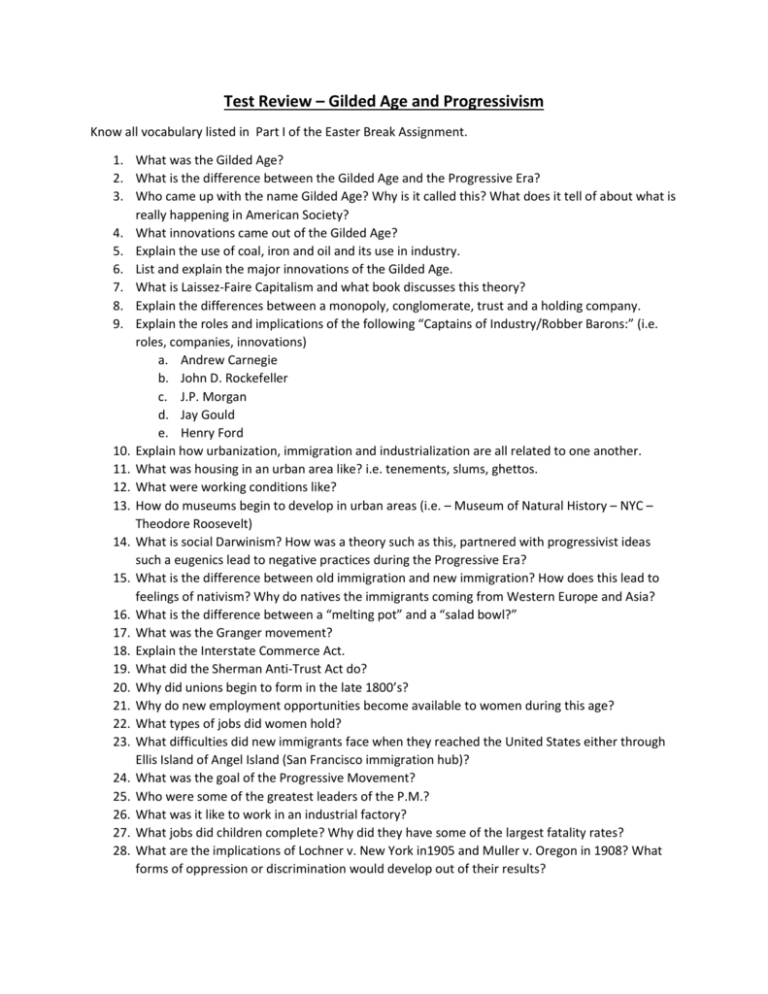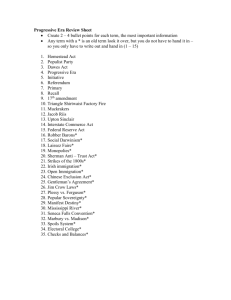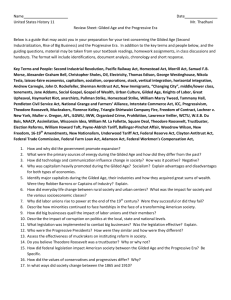Gilded Age/Progressive Era Test Review Sheet
advertisement

Test Review – Gilded Age and Progressivism Know all vocabulary listed in Part I of the Easter Break Assignment. 1. What was the Gilded Age? 2. What is the difference between the Gilded Age and the Progressive Era? 3. Who came up with the name Gilded Age? Why is it called this? What does it tell of about what is really happening in American Society? 4. What innovations came out of the Gilded Age? 5. Explain the use of coal, iron and oil and its use in industry. 6. List and explain the major innovations of the Gilded Age. 7. What is Laissez-Faire Capitalism and what book discusses this theory? 8. Explain the differences between a monopoly, conglomerate, trust and a holding company. 9. Explain the roles and implications of the following “Captains of Industry/Robber Barons:” (i.e. roles, companies, innovations) a. Andrew Carnegie b. John D. Rockefeller c. J.P. Morgan d. Jay Gould e. Henry Ford 10. Explain how urbanization, immigration and industrialization are all related to one another. 11. What was housing in an urban area like? i.e. tenements, slums, ghettos. 12. What were working conditions like? 13. How do museums begin to develop in urban areas (i.e. – Museum of Natural History – NYC – Theodore Roosevelt) 14. What is social Darwinism? How was a theory such as this, partnered with progressivist ideas such a eugenics lead to negative practices during the Progressive Era? 15. What is the difference between old immigration and new immigration? How does this lead to feelings of nativism? Why do natives the immigrants coming from Western Europe and Asia? 16. What is the difference between a “melting pot” and a “salad bowl?” 17. What was the Granger movement? 18. Explain the Interstate Commerce Act. 19. What did the Sherman Anti-Trust Act do? 20. Why did unions begin to form in the late 1800’s? 21. Why do new employment opportunities become available to women during this age? 22. What types of jobs did women hold? 23. What difficulties did new immigrants face when they reached the United States either through Ellis Island of Angel Island (San Francisco immigration hub)? 24. What was the goal of the Progressive Movement? 25. Who were some of the greatest leaders of the P.M.? 26. What was it like to work in an industrial factory? 27. What jobs did children complete? Why did they have some of the largest fatality rates? 28. What are the implications of Lochner v. New York in1905 and Muller v. Oregon in 1908? What forms of oppression or discrimination would develop out of their results? 29. Who were the Muckrakers and what did the hope to achieve? How would they do this? Provide 4 examples (names and examples.) 30. Why did women and religious groups push for the temperance and prohibition movement? 31. How did women’s rights evolve out of this era? 32. What is the difference between suffrage and suffragettes? 33. What election reform was made during the progressive era? Why was this needed during an age of politics influences on immigration development? 34. What is the direct election of senators? 35. Who was Theodore Roosevelt? How did he first take office in 1901? Why is he known as the modern president? What were the Rough Riders? Why is his presidency known as the square deal? (He is known as the first of the Progressive Presidents – 1st of 3.) 36. What is trust busting? What was Roosevelt’s role in this? 37. What four regulations were made for business? Explain. a. Railroad Legislation b. Trust-Busting c. Northern Securities Case d. “Beef Trust” 38. What three labor conditions/changes developed during the Progressive Era? Explain a. Anthracite Coal Strike b. Employers Liability c. Working hours 39. What role did Roosevelt play in creating opportunities for conservation? 40. What major reforms occurred under Taft? 41. What reforms occurred under Woodrow Wilson? 42. What is new Nationalism?











